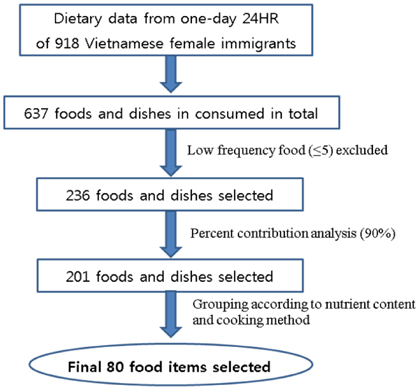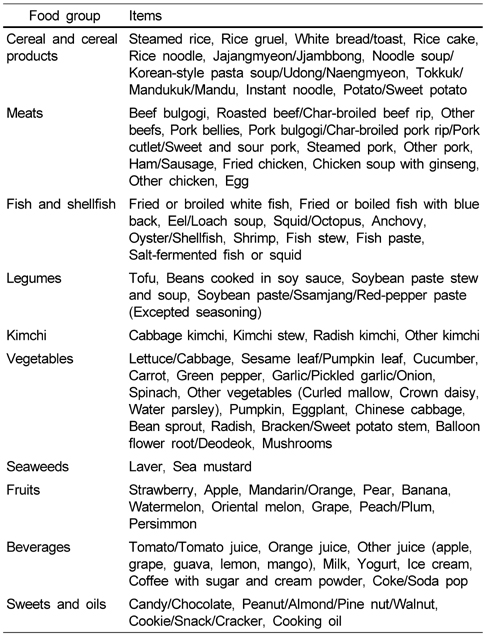Nutr Res Pract.
2011 Jun;5(3):260-265.
Development and evaluation of a food frequency questionnaire for Vietnamese female immigrants in Korea: the Korean Genome and Epidemiology Study (KoGES)
- Affiliations
-
- 1Department of Nutritional Science and Food Management, Ewha Womans University, Seoul 120-750, Korea.
- 2Graduate School of Education, Sangmyung University, Seoul 110-743, Korea.
- 3Department of Obstetrics and Gynecology, Ewha Womans University School of Medicine, Seoul 120-750, Korea.
- 4Department of Food and Nutrition, Dongduk Women's University, 23-1 Wolgokdong, Sungbuk-gu, Seoul 136-714, Korea. yjyang@dongduk.ac.kr
Abstract
- The objectives of this study were to develop a food-frequency questionnaire (FFQ) for Vietnamese female immigrants in Korea and to evaluate the validity of the FFQ. A total of 80 food items were selected in developing the FFQ according to consumption frequency, the contribution of energy and other nutrients, and the cooking methods based on one-day 24 hour recall (24HR) from 918 Vietnamese female immigrants between November 2006 and November 2007. The FFQ was validated by comparison with 24HR of 425 Vietnamese female immigrants between November 2008 and August 2009. The absolute nutrient intake calculated from the FFQ was higher than that estimated by 24HR for most nutrients. The correlation coefficients between 24HR and FFQ ranged from 0.10 (vitamin C) - 0.36 (energy) for crude intake, 0.05 (vitamin E) - 0.32 (calcium) for per 1000 kcal, and 0.08 (zinc) - 0.34 (calcium) for energy-adjusted, respectively. More than 70% of subjects were classified into the same or adjacent agreement groups for nutrients other than fiber, sodium, vitamin A, vitamin C, and vitamin E, while less than 10% of subjects were classified into complete disagreement groups. We conclude that the FFQ appears to be an acceptable tool for estimating nutrient intake and dietary patterns of Vietnamese female immigrants in Korea. Future studies to validate the FFQ using various biomarkers or other dietary assessment methods are needed.
MeSH Terms
Figure
Reference
-
1. Population, households. Korea National Statistical Office [internet]. cited 2009 May 21. Seoul: Korea National Statistical Office;Available from: http://www.nso.go.kr/.2. Goel MS, McCarthy EP, Phillips RS, Wee CC. Obesity among US immigrant subgroups by duration of residence. JAMA. 2004. 292:2860–2867.
Article3. Mellin-Olsen T, Wandel M. Changes in food habits among Pakistani immigrant women in Oslo, Norway. Ethn Health. 2005. 10:311–319.
Article4. Neuhouser ML, Thompson B, Coronado GD, Solomon CC. Higher fat intake and lower fruit and vegetables intakes are associated with greater acculturation among Mexicans living in Washington state. J Am Diet Assoc. 2004. 104:51–57.
Article5. Park SY, Murphy SP, Sharma S, Kolonel LN. Dietary intakes and health-related behaviours of Korean American women born in the USA and Korea: The Multiethnic Cohort Study. Public Health Nutr. 2005. 8:904–911.
Article6. Lee WP, Lingard J, Bermingham M. Change in diet and body mass index in Taiwanese women with length of residence in Australia. Asia Pac J Clin Nutr. 2007. 16:56–65.7. Schultz JD, Spindler AA, Josephson RV. Diet and acculturation in Chinese women. J Nutr Educ. 1994. 26:266–272.
Article8. Lyu JE, Yang YJ, Lee SE, Chung HW, Kim MK, Kim WY. Nutritional Status of Vietnamese Female Marriage Immigrants to Korea in Relation to Length of Residence in Korea. Ann Nutr Metab. 2009. 55:317–324.
Article9. Ngo J, Gurinovic M, Frost-Andersen L, Serra-Majem L. How dietary intake methodology is adapted for use in European immigrant population groups - a review. Br J Nutr. 2009. 101:S86–S94.
Article10. Delisle HF, Vioque J, Gil A. Dietary patterns and quality in West-African immigrants in Madrid. Nutr J. 2009. 8:3.
Article11. Gimeno SG, Hirai AT, Harima HA, Kikuchi MY, Simony RF, de Barros N Jr, Cardoso MA, Ferreira SR. Japanese-Brazilian Diabetes Study Group. Fat and fiber consumption are associated with peripheral arterial disease in a cross-sectional study of a Japanese-Brazilian population. Circ J. 2008. 72:44–50.
Article12. Willet WC, Lenart E. Willett W, editor. Reproducibility and validity of food frequency questionnaire. Nutritional Epidemiology. 2nd edn. New York: Oxford University Press.13. Shu XO, Yang G, Jin F, Liu D, Kushi L, Wen W, Gao YT, Zheng W. Validity and reproducibility of the food frequency questionnaire used in the Shanghai Women's Health Study. Eur J Clin Nutr. 2004. 58:17–23.
Article14. Kim SH, Hwang JY, Kim MK, Chung HW, Nguyet TT, Kim WY. Dietary factors related to body weight in adult Vietnamese in the rural area of Haiphong, Vietnam: the Korean Genome and Epidemiology Study (KoGES). Nutr Res Pract. 2010. 4:235–242.
Article15. Dietary references intake for Koreans. 2005. Korea: The Korean Nutrition Society.16. The Korean Nutrition Society: Nutrition Information Center. Nutritional Assessment Program, 'CAN pro 3.0'. 2006.17. Ahn Y, Kwon E, Shim JE, Park MK, Joo Y, Kimm K, Park C, Kim DH. Validation and reproducibility of food frequency questionnaire for Korean genome epidemiologic study. Eur J Clin Nutr. 2007. 61:1435–1441.
Article18. Furlan-Viebig R, Pastor-Valero M. Development of a food frequency questionnaire to study diet and non-communicable diseases in adult population. Rev Saude Publica. 2004. 38:581–584.19. Kusama K, Le DS, Hanh TT, Takahashi K, Hung NT, Yoshiike N, Yamamoto S. Reproducibility and validity of a food frequency questionnaire among Vietnamese in Ho Chi Minh City. J Am Coll Nutr. 2005. 24:466–473.
Article20. Kim SH, Kim WY, Lyu JE, Chung HW, Hwang JY. Dietary intakes and eating behaviors of Vietnamese female immigrants to Korea through marriage and Korean spouses and correlations of their diets. Korean J Community Nutr. 2009. 14:22–30.21. Wang X, Sa R, Yan H. Validity and reproducibility of a food frequency questionnaire designed for residents in north China. Asia Pac J Clin Nutr. 2008. 17:629–634.22. Cheng Y, Yan H, Dibley MJ, Shen Y, Li Q, Zeng L. Validity and reproducibility of a semi-quantitative food frequency questionnaire for use among pregnant women in rural China. Asia Pac J Clin Nutr. 2008. 17:166–177.23. Ogawa K, Tsubono Y, Nishino Y, Watanabe Y, Ohkubo T, Watanabe T, Nakatsuka H, Takahashi N, Kawamura M, Tsuji I, Hisamichi S. Validation of a food-frequency questionnaire for cohort studies in rural Japan. Public Health Nutr. 2003. 6:147–157.
Article24. Tsugane S, Kobayashi M, Sasaki S. JPHC. Validity of the self-administered food frequency questionnaire used in the 5-year follow-up survey of the JPHC Study Cohort I: comparison with dietary records for main nutrients. J Epidemiol. 2003. 13:S51–S56.
Article25. Choi MS, Han KY, Park KS. Comparison of dietary intakes by 24-h dietary recall, dietary record and food frequency questionnaire among elderly people. Korean J Nutr. 2001. 34:688–700.26. Andersen LF, Solvoll K, Johansson LR, Salminen I, Aro A, Drevon CA. Evaluation of a food frequency questionnaire with weighed records, fatty acids, and alpha-tocopherol in adipose tissue and serum. Am J Epidemiol. 1999. 150:75–87.
Article27. Lee RD, Nieman DC. Nutritional Assessment. 1999. 2nd ed. St. Louis: Mosby.
- Full Text Links
- Actions
-
Cited
- CITED
-
- Close
- Share
- Similar articles
-
- Expansion of a food composition database for the food frequency questionnaire in the Korean Genome and Epidemiology Study (KoGES): a comprehensive database of dietary antioxidants and total antioxidant capacity
- Development of Nutrition Education Program for Vietnamese Female Marriage Immigrants in Korea Based on the Health Belief Model
- Intrahousehold discrepancy regarding food insecurity within intermarried couples of Vietnamese wives and Korean husbands in South Korea
- Nutrition survey methods and food composition database update of the Korean Genome and Epidemiology Study
- Changes in Dietary Quality among Vietnamese Women Immigrants in Korea and Comparison with Korean Women



